
STRUCTURAL CHEMISTRY
Scope & Guideline
Transforming Understanding through Structural Analysis
Introduction
Aims and Scopes
- Synthesis and Characterization of Chemical Compounds:
The journal frequently publishes studies related to the synthesis of novel compounds, including coordination complexes, organic dyes, and metal-organic frameworks, often accompanied by comprehensive characterization techniques such as X-ray crystallography and spectroscopic methods. - Computational Chemistry and Theoretical Studies:
A significant portion of the articles utilizes computational methods, particularly density functional theory (DFT), to explore electronic structures, reaction mechanisms, and material properties, providing insights that complement experimental findings. - Intermolecular Interactions and Supramolecular Chemistry:
Research often delves into the nature of intermolecular interactions, such as hydrogen bonding and π-π stacking, and their implications for the stability and functionality of complex structures, including polymers and nanomaterials. - Material Science and Applications:
The journal highlights studies that bridge structural chemistry with practical applications in fields like catalysis, drug design, and materials science, focusing on how molecular structure influences material properties and performance. - Biological and Medicinal Chemistry:
There is a consistent emphasis on the design and analysis of compounds with potential biological activity, including drug development studies that utilize computational and experimental approaches to understand interactions with biological targets.
Trending and Emerging
- Computational Materials Science:
The use of advanced computational techniques to predict and characterize the properties of new materials, including nanostructures and hybrid systems, is on the rise, driven by the need for innovative solutions in electronics and energy storage. - Green Chemistry and Sustainable Practices:
Research focusing on environmentally friendly synthesis methods and the development of sustainable materials is increasingly prominent, reflecting a global push towards sustainability in chemistry. - Nanotechnology and Nanomaterials:
The exploration of nanomaterials, particularly in drug delivery and catalysis, has gained significant attention, as researchers investigate their unique structural properties and potential applications in various fields. - Machine Learning and Artificial Intelligence in Chemistry:
There is a growing trend towards incorporating machine learning and AI methodologies to analyze chemical data, predict molecular properties, and optimize synthesis routes, marking a shift towards more data-driven approaches. - Interdisciplinary Research Connecting Chemistry and Biology:
Increasingly, studies that merge chemical research with biological applications, particularly in drug discovery and molecular biology, are becoming more common, showcasing the importance of structural insights in therapeutic contexts.
Declining or Waning
- Traditional Organic Synthesis Methods:
There appears to be a waning interest in conventional organic synthesis methods that do not incorporate modern computational techniques or innovative approaches, as the journal shifts towards more interdisciplinary and computationally driven research. - Basic Inorganic Chemistry Studies:
Research focusing solely on fundamental inorganic compounds and their properties has seen a decline, as the journal increasingly prioritizes studies that connect structural insights with practical applications and advanced materials. - Classical Spectroscopic Techniques:
Though still relevant, papers solely relying on classical spectroscopic methods without a computational or theoretical component have decreased, reflecting a broader trend towards integrating computational analysis in structural studies.
Similar Journals

Results in Chemistry
Bridging Knowledge and Accessibility in ChemistryResults in Chemistry is a prominent journal published by Elsevier, dedicated to fostering innovation and disseminating cutting-edge research in the field of chemistry. With an ISSN of 2211-7156, this open-access journal has been committed to making scientific knowledge widely available since 2019, aligning with the global trend towards accessibility in research. Based in the Netherlands, it features interdisciplinary studies that span the breadth of general chemistry, contributing significantly to the academic dialogue within the scientific community. Despite currently holding a Q3 ranking in the miscellaneous category of chemistry and occupying the 228th position out of 408 in Scopus rankings, the journal is poised for growth, aiming to enhance its impact and visibility. Researchers, professionals, and students alike will find invaluable resources and insights within its pages, making Results in Chemistry an essential platform for those looking to stay abreast of advancements and trends in chemistry research up to the year 2024.
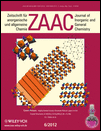
ZEITSCHRIFT FUR ANORGANISCHE UND ALLGEMEINE CHEMIE
Bridging Historical Knowledge with Modern DiscoveriesZEITSCHRIFT FUR ANORGANISCHE UND ALLGEMEINE CHEMIE, published by WILEY-V C H VERLAG GMBH, is a pivotal journal in the field of inorganic chemistry, catering to the needs of researchers, professionals, and students seeking to advance their understanding of this dynamic discipline. With its historical roots dating back to 1892 and a commitment to high-quality research, this journal provides a platform for the dissemination of significant findings related to inorganic substances and their general chemistry. Although currently not an open-access journal, it holds a competitive position with an impact factor placing it in the Q3 quartile of the Inorganic Chemistry category, ranking #57 out of 79 in Scopus. Situated in Germany, this journal not only connects past and present research endeavors but also aims to foster innovation and collaboration within the inorganic chemistry community. Whether you are exploring fundamental concepts or groundbreaking applications, ZEITSCHRIFT FUR ANORGANISCHE UND ALLGEMEINE CHEMIE remains an invaluable resource for advancing chemical sciences.
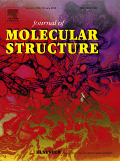
Journal of Molecular Structure
Empowering researchers with cutting-edge molecular research.Journal of Molecular Structure is a premier publication in the field of chemistry, offering a platform for innovative research that spans analytical, inorganic, organic chemistry, and spectroscopy. Published by Elsevier in the Netherlands, this journal is committed to advancing the understanding of molecular architecture and behavior through high-quality, peer-reviewed articles. With its impressive impact factor and a notable Scopus ranking placing it in the top quartiles among its peers, it serves as an essential resource for researchers, professionals, and students alike. The journal's open access options promote the dissemination of knowledge, ensuring that groundbreaking discoveries reach a broad audience. Established in 1967 and projected to continue through 2025, the Journal of Molecular Structure is vital for anyone engaged in the study of molecular interactions and structural analysis.
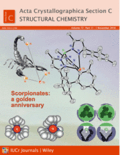
ACTA CRYSTALLOGRAPHICA SECTION C-STRUCTURAL CHEMISTRY
Delivering Rigorous Research in Structural ChemistryACTA CRYSTALLOGRAPHICA SECTION C-STRUCTURAL CHEMISTRY is a respected journal in the fields of condensed matter physics, inorganic chemistry, and materials chemistry, published by the International Union of Crystallography. With an extensive history dating back to its inception in the late 1980s, this journal serves as a significant platform for researchers to disseminate high-quality research on structural chemistry, focusing on the synthesis and characterization of crystalline materials. Despite currently holding a Q4 ranking across multiple academic categories, it remains an essential resource for those engaged in these scientific disciplines, facilitating dialogue and collaboration among experts. The journal's commitment to publishing innovative studies ensures that it continues to contribute to the advancement of knowledge in its field. Although it does not offer Open Access, the journal is dedicated to maintaining rigorous peer-review standards, making it a reliable source for scholars and practitioners alike. Located in the United States, ACTA CRYSTALLOGRAPHICA SECTION C is a pivotal part of the global crystallography community.
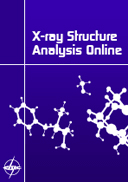
X-Ray Structure Analysis Online
Advancing the Frontiers of X-Ray AnalysisX-Ray Structure Analysis Online is a pivotal academic journal dedicated to the field of analytical and materials chemistry, published by the Japan Society for Analytical Chemistry. Established in 2009, this journal serves as a vital platform for researchers and professionals dedicated to advancing the understanding of X-ray structural analysis techniques and their applications. With ISSN 1883-3578, it operates under rigorous peer-review standards, promoting high-quality research contributions. While the journal is currently categorized in the Q4 quartile for both Analytical Chemistry and Materials Chemistry, its focus on cultivating a deeper understanding of material properties through X-ray analysis remains crucial for ongoing developments in these fields. By providing an accessible outlet for innovative studies, X-Ray Structure Analysis Online supports the academic community in overcoming the challenges of a rapidly evolving scientific landscape. It is particularly valuable for those engaged in material and analytical research, offering insights that contribute to both theoretical foundations and practical applications.

Computational and Theoretical Chemistry
Exploring the Nexus of Theory and ComputationComputational and Theoretical Chemistry, published by ELSEVIER, stands at the forefront of interdisciplinary research in the realms of computational chemistry, theoretical physics, and biochemistry. With its ISSN 2210-271X and E-ISSN 1872-7999, the journal has established a significant presence in the academic community since its inception. Covering innovative computational methodologies and theoretical advancements, it addresses critical issues in condensed matter physics and molecular biochemistry, providing a rich resource for scholars and industry professionals alike. The journal enjoys a respectable impact factor and ranks notably in several Scopus categories, making it a vital platform for disseminating high-quality research. It adopts an open-access model, facilitating wider readership and engagement, which is essential for fostering collaborative innovations in the scientific landscape. As it continues to evolve from 2011 to 2024, Computational and Theoretical Chemistry is committed to advancing knowledge and promoting insightful discussions within the scientific community.
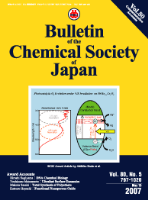
BULLETIN OF THE CHEMICAL SOCIETY OF JAPAN
Illuminating Pathways: The Heartbeat of Chemical ResearchBULLETIN OF THE CHEMICAL SOCIETY OF JAPAN, published by the esteemed Chemical Society of Japan, serves as a pivotal platform for the dissemination of cutting-edge research in the multifaceted field of chemistry. With an ISSN of 0009-2673 and an E-ISSN of 1348-0634, this journal has been integral in fostering the growth of chemical sciences globally since its inception in 1965. The journal holds an impressive Q2 ranking in the Chemistry (miscellaneous) category, indicating its relevance and influence within the academic community, as reflected by its Scopus rank of #104/408, placing it in the 74th percentile. Although it is not an open-access journal, its rich content, which spans a wide range of topics in general chemistry, remains highly valued by researchers, professionals, and students alike, affirming its crucial role in advancing both theoretical knowledge and practical applications in chemistry. As it converges towards 2024, the bulletin continues to uphold its commitment to excellence in scientific communication and research dissemination in Japan and beyond.

JOURNAL OF CHEMICAL RESEARCH
Exploring the Frontiers of Chemical Science.JOURNAL OF CHEMICAL RESEARCH, published by SAGE PUBLICATIONS LTD, serves as a pivotal platform for scholars and practitioners in the field of Chemistry. With its ISSN 1747-5198 and E-ISSN 2047-6507, this journal has established itself as a reliable source of innovative research since its inception in 2000. The journal's comprehensive scope encompasses various facets of chemical research, providing a broad spectrum of articles that foster scientific advancement and technological innovation. Ranked in the Q3 tier of miscellaneous chemistry journals in 2023, with a Scopus rank of #246 out of 408, it represents a solid outlet for emerging and established researchers alike. Although currently not an open-access journal, its rigorous peer-review process ensures that only high-quality studies are published, catering to the academic and professional community's demand for credible and impactful findings. Positioned in the vibrant research landscape of the United Kingdom, the JOURNAL OF CHEMICAL RESEARCH is dedicated to expanding the frontiers of chemical sciences and is an essential resource for anyone committed to advancing this dynamic field.
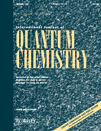
INTERNATIONAL JOURNAL OF QUANTUM CHEMISTRY
Illuminating the Path of Quantum DiscoveriesInternational Journal of Quantum Chemistry is a distinguished scholarly publication that has been at the forefront of advancements in the realm of quantum chemistry since its inception in 1967. Published by Wiley in the United States, this journal holds a significant place in the academic community, currently indexed in the Q3 quartile across various categories including Atomic and Molecular Physics, Condensed Matter Physics, and Physical and Theoretical Chemistry. With an ISSN of 0020-7608 and an E-ISSN of 1097-461X, the journal offers a platform for researchers and professionals to disseminate cutting-edge findings in quantum chemical research. While it operates under a traditional subscription model, the journal remains committed to enhancing the visibility of its contributions within the scientific community. With a convergence of research that spans from 1967 to 2024, the International Journal of Quantum Chemistry is pivotal for anyone looking to advance their understanding and application of quantum principles in chemistry, providing valuable insights into the microscopic interactions that govern matter and its properties.

INDIAN JOURNAL OF CHEMISTRY
Connecting Researchers to the Latest in Organic, Inorganic, and Physical ChemistryINDIAN JOURNAL OF CHEMISTRY, published by the NATL INST SCIENCE COMMUNICATION & POLICY RESEARCH (NIScPR), stands as a vital platform for disseminating innovative research and advancements in the fields of organic, inorganic, and physical chemistry. With its inception in 1969, this journal has served the global community of chemists and researchers, contributing significantly to the advancement of chemical sciences in India and beyond. The journal maintains a strong commitment to open access, facilitating widespread dissemination of knowledge, allowing readers from diverse backgrounds to access cutting-edge research without barriers. Although coverage in Scopus has been temporarily discontinued, the journal continues to uphold rigorous scholarly standards, making it an authoritative source for academicians, professionals, and students alike. Readers can expect high-quality articles that reflect the latest developments and discoveries in chemistry, reinforcing the journal's reputation as an essential resource in the scientific community.